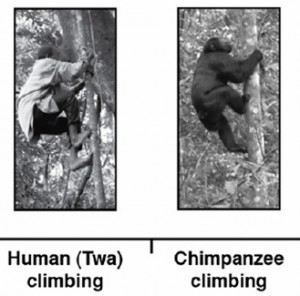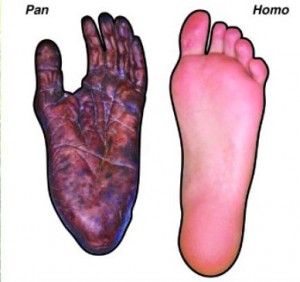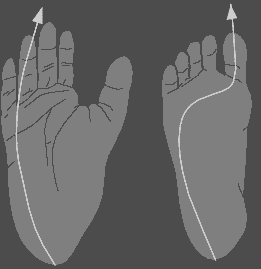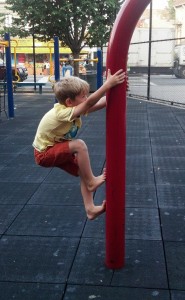Chimpanzee feet are amazing to explore if you are interested in how humans walk, and two recent studies have shed interesting new light on our similarities and differences depending on how you interpret them.
As I mentioned in last Saturday’s post my daughter Ida and I recently spent time in The Hall of Human Origins At The American Museum Of Natural History.
Left to my own devices I can easily get lost in there.
Chimpanzee feet are quite different from human feet and there is much to be gleaned from the difference.
Conventional wisdom has always claimed that the human mid-foot is rigid, which allows more efficient walking while chimpanzees and other apes have flexible feet better suited to grasping branches as they move through the trees.
The three-arch system of the human foot is not found in Chimpanzee feet.
The arches of human feet are both rigid and pliable depending on need.
The human foot is a spring arch that should be able to drop and lift with every step. If the foot doesn’t actually do this it is a flaw of function rather than design.
We refer to Chimpanzees as knuckle-walkers because they can only walk on two legs for short distances due to differences in the design of our legs and spine.
Chimps cannot straighten their legs like humans and they don’t have a lumbar curve which makes weight-bearing and walking much more difficult.
So while chimp feet and bodies can’t do what humans can, I think it shouldn’t be a problem for our feet to work like Chimpanzee feet.
Human legs angle in from the hip to the knee allowing our feet to fall directly under the pelvis and our pelvic muscles are much stronger as well, allowing for a stable upright environment.
Chimpanzee legs are set wide apart and weak pelvic muscles force their whole body to transfer weight from side to side during each step.
A recent study by Jeremy DeSilva and Simone Gill at Boston University, asked 400 adults to walk barefoot around the Boston Museum of Science while they filmed their feet.
The experiment revealed that 8 per cent of people have some mid-foot flexibility, rather like Chimpanzee feet.
Brief Communication: A Mid-Tarsal Break in the Human Foot Another group of researches, Vivek Venkataraman, Thomas Kraft and Nathaniel Dominy, at Dartmouth focused on a tree climbing community in Uganda where the villagers are able to climb trees almost exactly like chimpanzees. (Amazing video at this link.)
 But my takeaway from these two studies is that if we were not shod and walking on hard floors and streets all the time, our human feet would easily be able to work like Chimpanzee feet.
But my takeaway from these two studies is that if we were not shod and walking on hard floors and streets all the time, our human feet would easily be able to work like Chimpanzee feet.
In the Boston University study it was discovered that almost 10% of human feet have the mobility of Chimpanzee feet, and in the Dartmouth study we see a society that has functionally adapted their foot and calf muscles to allow them to climb trees like they had Chimpanzee feet.
What it says to me is that we are supremely adaptable to both good and bad environments and stimuli and we have to make conscious choices about how to develop our bodies.
And to finish, here are the two different ways that my barefoot children climb poles—one more chimp-like, than the other. I’ll have to get Ida to work on her Chimpanzee feet.





